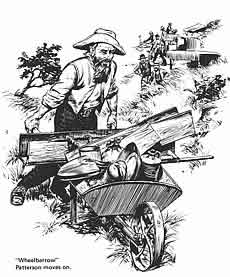 FOR MORE INFORMATION ON THE CHARACTERS OF THE GOLD RUSH FOR MORE INFORMATION ON THE CHARACTERS OF THE GOLD RUSH
This page deals with the history of Pilgrims Rest in Mpumalanga South Africa, including historical photos of Pilgrims Rest and further information on the Pilgrims Rest Diggers and the 1873 gold rush.
Evidence of mine diggings at Pilgrim's Rest goes back to ancient times when unknown people worked the gold bearing quartz reefs for this precious metal.
Signs of early mining activity can be found in the
north and eastern parts of South Africa as well as Zimbabwe.
A number of insignificant gold deposits were discovered in the northern parts of South Africa between 1840 and 1870.
The Pilgrims Rest gold rush was situated in one of the most beautiful and healthy settings of any gold rush in history.
How did it happen?
The first discovery of gold in the Transvaal which led to the first gold rush in South Africa, took place in 1873
when payable gold was discovered on the farm Geelhoutboom near the town of Sabie in Mpumalanga.
President Burgers, who visited
the site, named the camp "Mac Mac" and declared the area the New Caledonia Gold Fields.
This discovery saved the Boer Republic of the Transvaal (ZAR. Zuid Afrikaansche Republiek) from bankruptcy.
PILGRIMS REST HISTORICAL PHOTOS GALLERY
Compiled by Louis-John Havemann
Most of these photos were scanned from "Pilgrims Rest A Pictorial History".
Any further information, photos and images would be gratefully received
and recorded
with credits:
email lj-tours@iafrica.com
I have received a request for help which I attach and if anyone could help, please contact me at the above email address;
"Mr. Havemann - I came across your excellent website while looking for information on Pilgrims Rest. A grand uncle of mine ran a business there in the early 1900s. I wonder if you know of any resources I might use to find out more about him and his store. The family name was Benci and I believe he had two stores, possibly drygoods. Thank you for any help you can provide. John Crandall"
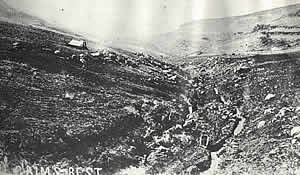
This is the first known photo taken of Pilgrims Rest showing the diggings of late 1873 or early 1874.
This photo was taken from the opposite bank to the Lower Camp. Notice how few trees there were. |
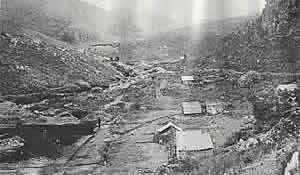
This is a photo of the early diggings. along what became known as Pilgrims Creek as well as Peach Tree Creek named after the peach trees that grew along its banks. There were also claims along other creeks and streams in the area.
|
|
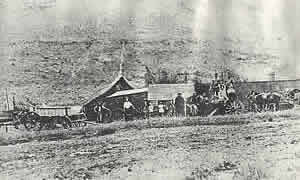
In the 19th century the wagon builders shop was just as important as today's motor car garages. Wagons were the only means of bulk transport over very rough and primitive roads and tracks. |

The settlement is growing with corrugated iron buildings appearing among the tents.
This building material only started to be used from 1876 onwards. Pilgrims Rest is renowned for it's corrugated iron buildings |
|
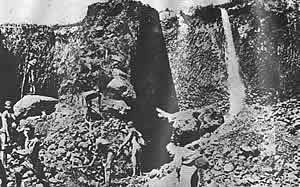
Alluvial gold is found in streams and rivers where it is washed down by erosion and sometimes covered by eroded soil. This necessitated the overburden of soil to be removed before these layers of alluvial gold were found. Large amounts of water were needed to wash the gravel in order to find the alluvial gold.
|
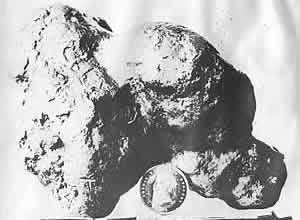
THE PERSERVERANCE or LILLEY NUGGET:
This nugget was found on 16 December 1874 and weighed 119 ounces and 2 pennyweights.
It was at the time the largest nugget found in South Africa. It was found by George Russel, F.W.Wormald, S.J.Lilley and G.W.Boycott.
President Burgers bought the nugget during his visit of that year.
|
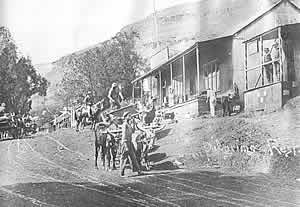
This was the main road during the 1890's and despite appearances was very busy.
This building later became the Post Office.
Store Keepers displayed their goods on the verandahs to attract passing trade.
|
| 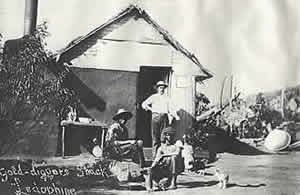
Ponieskrantz was the first farm to be proclaimed a gold field. There were others like Ledophine, Lisbon and Graskop.
This digger was fairly well off as he has a permanent home covered by a layer of thatch for coolness. The tools of his trade (His pestle, mortar and gold pan) are held by his worker in front
|
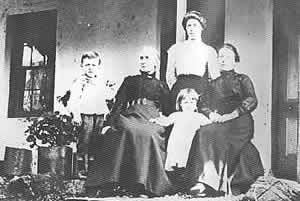
Four generations are pictured here. Standing at the back is Maud Mary Purcell the first white child born at Pilgrims Rest on 24 August 1874.
Standing in front of her is her daughter who became Sheila Mary Marguerite MacFarlane who on her departure in 1978 was the oldest inhabitant of Pilgrims Rest.
The house behind them became the Free Masons Lodge
|
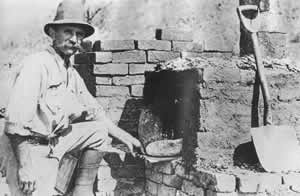
Not everyone at Pilgims Rest was a digger. There were many others who provided much needed services like wagon makers, blacksmiths, traders, tent making and catering establishments and of course many taverns dispensing liquor.
Here is a baker preparing a loaf of bread.
|
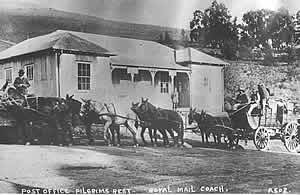
The first transport service to Pilgrims Rest was William Leathern's wagon. this traveled to Lydenburg every weekend. Leathern claimed that he never left anyone at Lydenburg no matter what his condition. In the 1880's came the Zeederberg Coach Service which was also the mail service. This is the Royal Mail Coach outside the Post Office.
|

EARLY ORE TRANSPORTATION
Pictured here is a wagon carting ore to the reduction works.
All early transportation was by means of ox wagon, normally drawn by a team of 14 oxen. Rail transport took over when the line to Graskop was opened in 1914.
This mode of transport was very slow so an alternative power source such electricity was investigated
|
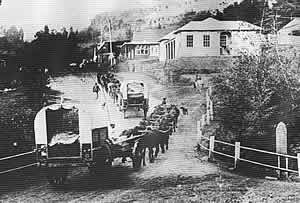
Wagons pictured bringing in their loads after 1900.
Because of the mountainous terrain most wagons were fitted with special ratchet brakes to the back wheels.
These brakes stopped them running backwards and saved the "Brake Boy" having to turn the brake crank handle.
|
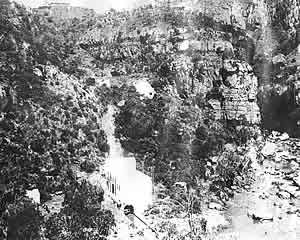
BELVEDERE HYDRO-ELECTRIC POWER STATION
This 3rd power station was at Belvedere in the Blyde Canyon 35kms away.
The 1st was at Brown's Hill which got struck by lightning and burnt out.
The 2nd one at Jubilee got washed away in the 1909 floods. When the river was low, not enough power could be generated, so in the 1930's another 4th one at the reduction works was built and used until 1973 as an emergency power source. Pilgrims Rest was the 2nd town in South africa to have electricity. This was when London still had gas street lights.
|

R.W.RICHARDSON GOVT. MAIL CONTRACTOR
R.W.Richardson took over the government contract to transport passengers from Graskop to Pilgrims Rest as well as mail deliveries, from Zeederburg Coach Services.
This photo was taken in 1915 and it is uncertain if the baboon on the bonnet was the ticket collector or not.
|
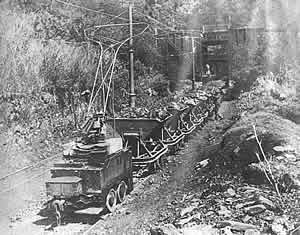
Mr. Wertheman, the first consulting engineer for TGME (Transvaal Gold Mining Enterprises) came up with the idea of an electric tramway to carry ore from the various mines to the central reduction works. There was no coal nearby so electricity was the only alternative. The power station at Browns Hill was enlarged and all the tramlines and power standards had to be imported at great cost.
In this photo you can see ore being transferred to an ore bin in the background.
|

J.H. De BEER'S BUTCHERY & BAKERY
J.H.De Beer nicknamed "Maboompi" was a well known person as a pioneer of Pilgrims Rest.
He built a number of houses in Pilgrims Rest including the well known Rose Cottage in the main street.
During the Boer War he was involved in the Siege of Ladysmith, together with other Pilgrims Rest members of his commando.
|
|
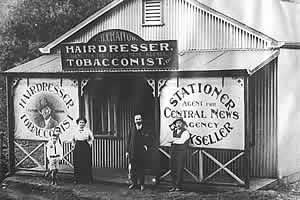
C.H.CHAITOW TOBACCONIST & HAIRDRESSER
C.H.Chaitow was the hairdresser and tobacconist shop as well as being the agent for
Central News Agency and a book shop.
His son is in the 1913 school photograph.
Like most shop owners the family lived at the back of their shop.
|
|
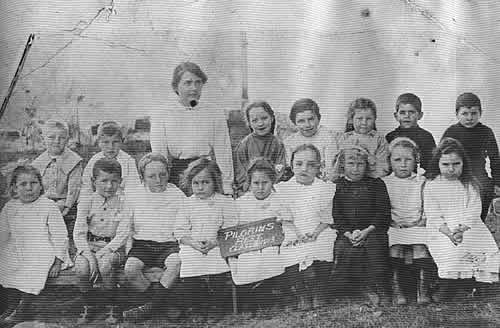
MISS McNALLY'S BABY CLASS 1913: Miss McNally was the daughter of the owner of the "Pilgrim's and Sabie News". The school was operational from 1894 - 1917 and had at one stage 6 teachers, and between 160 - 180 pupils. The school had two classrooms at this time. In this photo we see Miss McNally and in the back row on her right is Allen MacKenzie the Post Master's son and Donald Menzies the Chemist's son. On her left back row from L - R, Unknown, Unknown, Violet Charlton (Her father worked at Driekop), Christie Markus (Later Oom Christie) and Frankie Beretta
Front row L - R, Unknown,Boris Chaitow (The Hairdresser's son), James Doig, The Two Sheppard Sisters, Unknown, Susanna Potgieter, Unknown, Unknown.
Other teachers at this time were Mr. Harry Coles and Mrs. Patterson. After the Anglo Boer War this school became one of the famous "Milner Schools". At the end of the Anglo-Boer War, because education had virtually fallen apart during the war, Lord Milner set about putting things right and the various schools he established were known as the Milner Schools.
I received this email from Ann Pare and have uploaded it to this page, in the hopes that someone could help her with her request. "I read with great interest your Pilgrims Rest Historical Photo gallery and note the mention of my great uncle's name Mr. Coles as a teacher in 1913. He was my father's uncle. Mr. Harry Coles, a teacher, came to South Africa settling in Pilgrim's Rest before World War 1 from England, because his wife Edith, had TB of the hip and was advised she would do better in a warmer climate. My parents, my brother and I came to meet Uncle Harry in Pilgrims Rest in the early 1960's when we lived in South Africa; we met Uncle Harry again in 1965 in Durban where he had retired to. He passed away in approx 1964/1965. If you have any photos of Mr. Coles in relation to him teaching in Pilgrim's Rest I would be interested to see them. Thank You, Anne Par E-mail: pare.anne@powergate.ca ( Uxbridge, Ontario, Canada)"
|
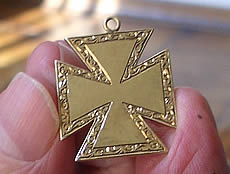
|
President Burgers in 1874 had three of these crosses struck out of Pilgrims Rest gold and presented them to three ladies.
The first cross was given to Mrs Tom ( Emma) Maclachlan (Her husband owned the farm Geelhoutboom where gold was found and the Mac Mac fields started). She was given the medal in recognition for her sterling work in nursing men at the diggings who were suffering from malaria and blackwater fever.
The second medal was presented to her ward Miss Maria Espach, later to become Mrs. D. Austin, for her work in nursing men who had been wounded during the Sekhukhune war.
The third medal was presented to Catharina van Rees, for composing the ZAR national
anthem "Kent gij dat volk". |
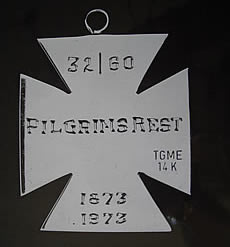
|
| |
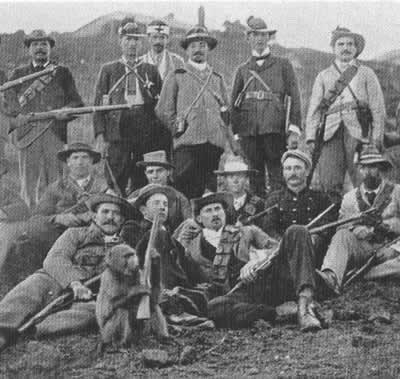
|
|
GENERAL BEN VILJOEN & STAFF:
General Ben Viljoen is standing in the middle with Capt Herklaas Malan on his left and Capt. Blyghout on his right
The "Hairy Burger" at the bottom left of the photo was a pet baboon kept by the Kommando.
During the guerrilla stage of the Boer war the Boer commandos in the eastern Transvaal were under the overall command of Assistant- Commandant- General Ben Viljoen.
At the time he established his headquarters at Pilgrim's Rest.
These commandos roamed much where they willed, but crossing the British blockhouse lines, especially along the railway, was becoming increasingly difficult.
They were well-horsed and knew what they were about, but they had little artillery and their ammunition and supplies were running short.
By July 1901, General Viljoen's forces had taken a serious number of casualties from the operations of Lt-General Sir Bindon Blood. He had set out to capture the Transvaal Govt, an objective which he never quite achieved.
The British were never quite able to clear the devastated and burnt eastern Transvaal of the Boers.
Even after his capture early in 1902, Ben Viljoen's successor, fighting General Muller, kept pressure on the British to the very end (May 1902) with raid and counter-raid.
The Boers were then described by The Times History as being as 'shy and wild as grouse in December'. |

This is the cairn marking
the spot of his capture
outside Lydenburg which reads:- |
"At this drift Ass-Cmdt-Gen Ben J. Viljoen was taken prisoner in an ambush on the night of 25 Jan 1902 by British soldiers under Maj. Orr while he and 4 adjutants were on their way to their headquarters at Pilgrims Rest.
Adjs J.Nel and L. Jordaan were killed, Adj Bester was captured while J.Coetzee escaped.
The ambush was meant for the itinerant government under Acting Pres. S.W. Burger at the time in the Oshoek area.
General Viljoen was sent prisoner of war to St Helena." |
|
|


